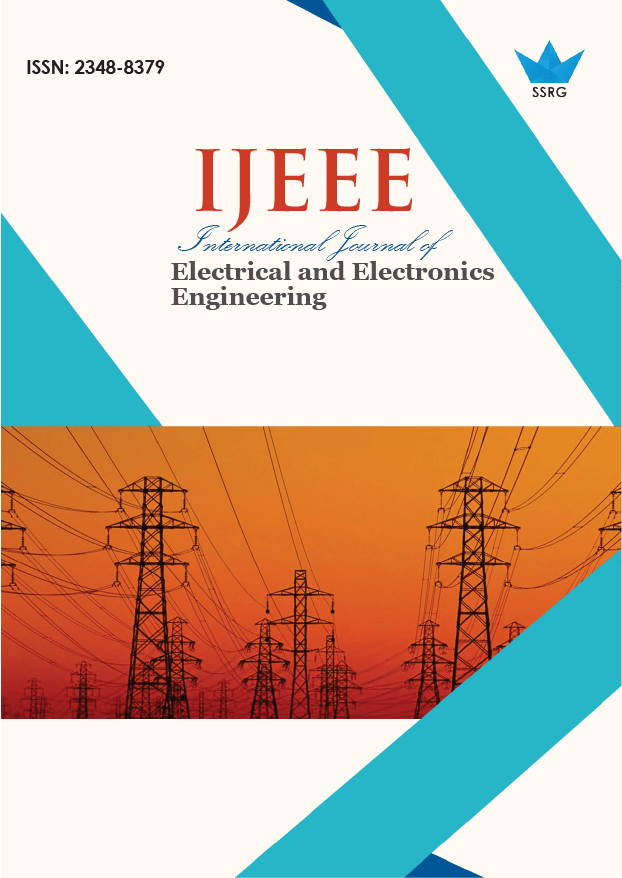Real Time Implementation of Maximum Power Point and Insolation Tracking Under Normal and Partial Shading Conditions for Standalone PV System

| International Journal of Electrical and Electronics Engineering |
| © 2025 by SSRG - IJEEE Journal |
| Volume 12 Issue 8 |
| Year of Publication : 2025 |
| Authors : Hamed Ghasab Hamed Al-Mashrafi, Mohammed Jabir Ahmed Mohamed Al Faraey, Loganathan Venkateswaran, Rajababu Natarajan |
How to Cite?
Hamed Ghasab Hamed Al-Mashrafi, Mohammed Jabir Ahmed Mohamed Al Faraey, Loganathan Venkateswaran, Rajababu Natarajan, "Real Time Implementation of Maximum Power Point and Insolation Tracking Under Normal and Partial Shading Conditions for Standalone PV System," SSRG International Journal of Electrical and Electronics Engineering, vol. 12, no. 8, pp. 280-286, 2025. Crossref, https://doi.org/10.14445/23488379/IJEEE-V12I8P124
Abstract:
Due to various environmental conditions, the solar photovoltaic (PV) modules' output power is not always the maximum power they can produce. It becomes inexorable to track the maximum power point by adopting suitable techniques. Various methods are available to perform this tracking process, and perturb and observe (P&O) method is widely used due to its ease of implementation and simplicity. Although this method can track the maximum power point effectively, it has some limitations, like oscillation near the local maximum, thus preventing it from reaching the global maximum during partial shading conditions and increasing the time response. The power extracted will not be the actual maximum power that can be produced by the PV modules. To vanquish these impediments, a method that combines the P&O method with isolation tracking is proposed in this literature. The proposed method is more efficient than the traditional P&O method in extracting the maximum power under normal and partial shading conditions. The robustness of the proposed method is demonstrated by simulating the developed system, and the results are validated by the prototype developed.
Keywords:
Isolation tracking, Maximum power point tracking, Perturb and Observe method, Solar photovoltaic systems.
References:
[1] Nicola Femia et al., “Optimization of Perturb and Observe Maximum Power Point Tracking Method,” IEEE Transactions on Power Electronics, vol. 20, no. 4, pp. 963-973, 2005.
[CrossRef] [Google Scholar] [Publisher Link]
[2] Ashish Pandey, Nivedita Dasgupta, and Ashok Kumar Mukerjee, “High-Performance Algorithms for Drift Avoidance and Fast Tracking in Solar MPPT System,” IEEE Transactions on Energy Conversion, vol. 23, no. 2, pp. 681-689, 2008.
[CrossRef] [Google Scholar] [Publisher Link]
[3] Patrizio Manganiello et al., “Optimization of Perturbative PV MPPT Methods through Online System Identification,” IEEE Transactions on Industrial Electronics, vol. 61, no. 12, pp. 6812-6821, 2014.
[CrossRef] [Google Scholar] [Publisher Link]
[4] Fathima Raziya et al., “MPPT Technique Based on Perturb and Observe Method for PV Systems Under Partial Shading Conditions,” Proceedings of the Moratuwa Engineering Research Conference (MERCon), Moratuwa, Sri Lanka, pp. 474-479, 2019.
[CrossRef] [Google Scholar] [Publisher Link]
[5] Andrew Vinícius Silva Moreira et al., “An Adaptive Perturb and Observe Method with Clustering for Photovoltaic Module with Smart Bypass Diode under Partial Shading,” 2019 IEEE PES Innovative Smart Grid Technologies Conference - Latin America (ISGT Latin America), Gramado, Brazil,pp. 1-6, 2019.
[CrossRef] [Google Scholar] [Publisher Link]
[6] Shunlong Xiao, and Robert S. Balog, “An Improved Adaptive Perturb & Observe Maximum Power Point Tracking Technique,” 2018 IEEE Texas Power and Energy Conference (TPEC), College Station, TX, USA, pp. 1-6, 2018.
[CrossRef] [Google Scholar] [Publisher Link]
[7] Sathish Kumar Kollimalla, and Mahesh Kumar Mishra, “Adaptive Perturb & Observe MPPT Algorithm for Photovoltaic System,” 2013 IEEE Power and Energy Conference at Illinois (PECI), Urbana, IL, USA, pp. 42-47, 2013.
[CrossRef] [Google Scholar] [Publisher Link]
[8] Mohammed S Sheik, “Multiple Step Size Perturb and Observe Maximum Power Point Tracking Algorithm with Zero Oscillation for Solar PV Applications,” 2018 International Conference on Current Trends towards Converging Technologies (ICCTCT), Coimbatore, India, pp. 1-5, 2018.
[CrossRef] [Google Scholar] [Publisher Link]
[9] F.A.O. Aashoor, and F.V.P. Robinson, “A Variable Step Size Perturb and Observe Algorithm for Photovoltaic Maximum Power Point Tracking,” 2012 47th International Universities Power Engineering Conference (UPEC), Uxbridge, UK, pp. 1-6, 2012.
[CrossRef] [Google Scholar] [Publisher Link]
[10] Saptaparna Basu Roy Chowdhury, Alok Mukherjee, and Pritam Kumar Gayen, “Maximum Power Point Tracking of Photovoltaic System by Perturb & Observe and Incremental Conductance Methods under Normal and Partial Shading Conditions,” 2021 Innovations in Energy Management and Renewable Resources(52042), Kolkata, India, pp. 1-6, 2021.
[CrossRef] [Google Scholar] [Publisher Link]
[11] Mohammed A. Elgendy, Bashar Zahawi, and David J. Atkinson, “Operating Characteristics of the P&O Algorithm at High Perturbation Frequencies for Standalone PV Systems,” IEEE Transactions on Energy Conversion, vol. 30, no. 1, pp. 189-198, 2015.
[CrossRef] [Google Scholar] [Publisher Link]
[12] The ResearchGate website, 2025. [Online]. Available: https://www.researchgate.net/figure/PV-solar-cell-model-The-output-current-Ipv-of-the-PV-cell-model-can-be-defined-as-in_fig5_318860620
[13] Robert W. Erickson , and Dragan Maksimović, Fundamentals of Power Electronics, 3rd ed., Cham, Switzerland: Springer Nature, pp. 56, 2020.
[CrossRef] [Google Scholar] [Publisher Link]

 10.14445/23488379/IJEEE-V12I8P124
10.14445/23488379/IJEEE-V12I8P124